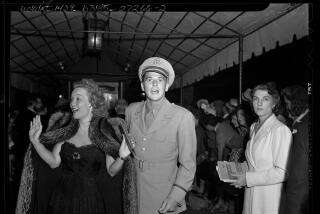A Divorce, 19th-Century American-Style : BOOK REVIEW / NOVEL : THE BLUESTOCKING: The Story of the Famous Forrest Divorce Case <i> by David Delman</i> ; St. Martin’s Press $21.95, 287 pages
- Share via
Now that divorce has become a 20th-Century rite of passage, it’s hard to imagine an era when news of a marital split would crowd international news off the front pages of 11 New York newspapers, but that was the case when Edward Forrest and Catherine Forrest sued and countersued each other--and for nothing more or less than adultery.
Although neither mayhem nor murder was involved, Edward Forrest was the leading American Shakespearean actor of his day, and his wife was that 19th-Century abomination, a bluestocking, “an advanced woman” who objected to her husband’s affairs with other women. That’s all it took to make headlines for more than a month and to qualify as the longest divorce case ever to be tried before the New York State Supreme Court.
When David Delman, the author of 14 novels, discovered the transcript of this trial, he vowed to make it the basis of his 15th.
Structure is provided by a young reporter named Henry Stewart, toiling for the irascible but brilliant editor of the New York Herald, James Gordon Bennett. (All characters, real and imagined, in this novel rate a minimum of two adjectives apiece.) Stewart is committed to his chosen profession, fair-minded but doggedly determined to cover every aspect of this sensational case.
In the course of his labors, he sympathizes with the brave, spirited, wronged Catherine Forrest, gradually coming to the conclusion that he’d be delighted to have an equally forward-thinking wife. Happily, he finds a candidate in the person of the enchanting, witty Serena Blaylock, and their burgeoning romance provides a pleasant counterpoint to the rancorous battles of the Forrests.
After a thorough perusal of the available evidence, the author has decided that Edward Forrest grew to hate his once-adored wife because she, like the loathed Macready, was British. Consumed by Anglophobia, Forrest seduced the actresses with whom he toured, but not apparently before assuring himself that they were American.
Driven to despair, but entirely innocent of any patriotic adultery, Catherine instituted a suit. Enraged at her effrontery, Edward Forrest bribed the household staff to perjure themselves by saying that Catherine had taken advantage of her husband’s absences to have romantic flings of her own, allegations that were eventually proven to be utterly false--but eventually is the key word here.
The vindication of Catherine Forrest consumes a great deal of time and space, and although she was represented by Charles O’Connor (tall, thin and aloof), the man who would eventually defend Jefferson Davis after the Civil War was not nearly as theatrical. John Van Buren (“forty and a shade”), the son of Martin Van Buren, was Edward Forrest’s attorney, and a less vibrant figure than his father, who seldom makes the short list of great American Presidents.
Sentences are convoluted and formal, and not only when the lawyers are arguing. When our reporter Stewart is taking a bath and attempting to forget a bad path in his relationship with the delightful Serena Blaylock, he “permitted the big toes of both feet to break the water line” as he says, at “a decibel level more circumspect than the previous night’s, ‘Hear me, Serena, I now banish you utterly from my brain.’ ”
Contemporary feminists will be gratified to learn that Catherine Forrest ultimately won the munificent (for 1851) settlement of $3,000 per annum. Revealing the sum isn’t actually giving away the plot.
More to Read
Sign up for our Book Club newsletter
Get the latest news, events and more from the Los Angeles Times Book Club, and help us get L.A. reading and talking.
You may occasionally receive promotional content from the Los Angeles Times.







